fuel pressure Lancia Ypsilon 2002 Owner handbook (in English)
[x] Cancel search | Manufacturer: LANCIA, Model Year: 2002, Model line: Ypsilon, Model: Lancia Ypsilon 2002Pages: 191, PDF Size: 2.45 MB
Page 70 of 191
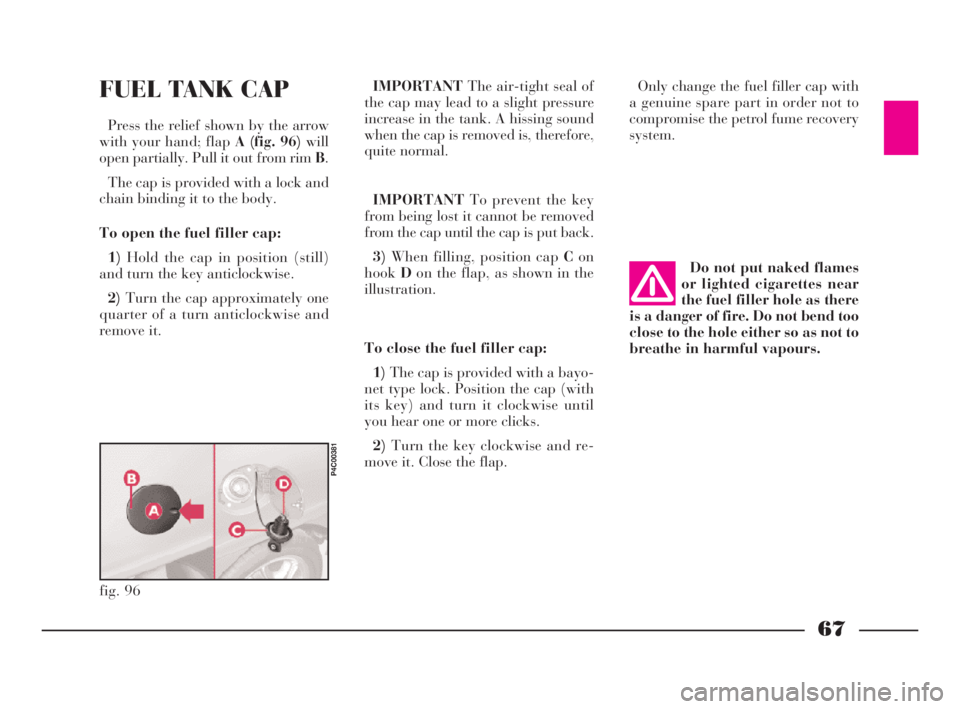
67
G
Only change the fuel filler cap with
a genuine spare part in order not to
compromise the petrol fume recovery
system.FUEL TANK CAP
Press the relief shown by the arrow
with your hand; flapA (fig. 96)will
open partially. Pull it out from rim B.
The cap is provided with a lock and
chain binding it to the body.
To open the fuel filler cap:
1)Hold the cap in position (still)
and turn the key anticlockwise.
2)Turn the cap approximately one
quarter of a turn anticlockwise and
remove it.IMPORTANTThe air-tight seal of
the cap may lead to a slight pressure
increase in the tank. A hissing sound
when the cap is removed is, therefore,
quite normal.
IMPORTANTTo prevent the key
from being lost it cannot be removed
from the cap until the cap is put back.
3)When filling, position cap Con
hookDon the flap, as shown in the
illustration.
To close the fuel filler cap:
1)The cap is provided with a bayo-
net type lock. Position the cap (with
its key) and turn it clockwise until
you hear one or more clicks.
2)Turn the key clockwise and re-
move it. Close the flap.Do not put naked flames
or lighted cigarettes near
the fuel filler hole as there
is a danger of fire. Do not bend too
close to the hole either so as not to
breathe in harmful vapours.
fig. 96
P4C00381
4C001-067 ING 11-03-2008 11:57 Pagina 67
Page 84 of 191
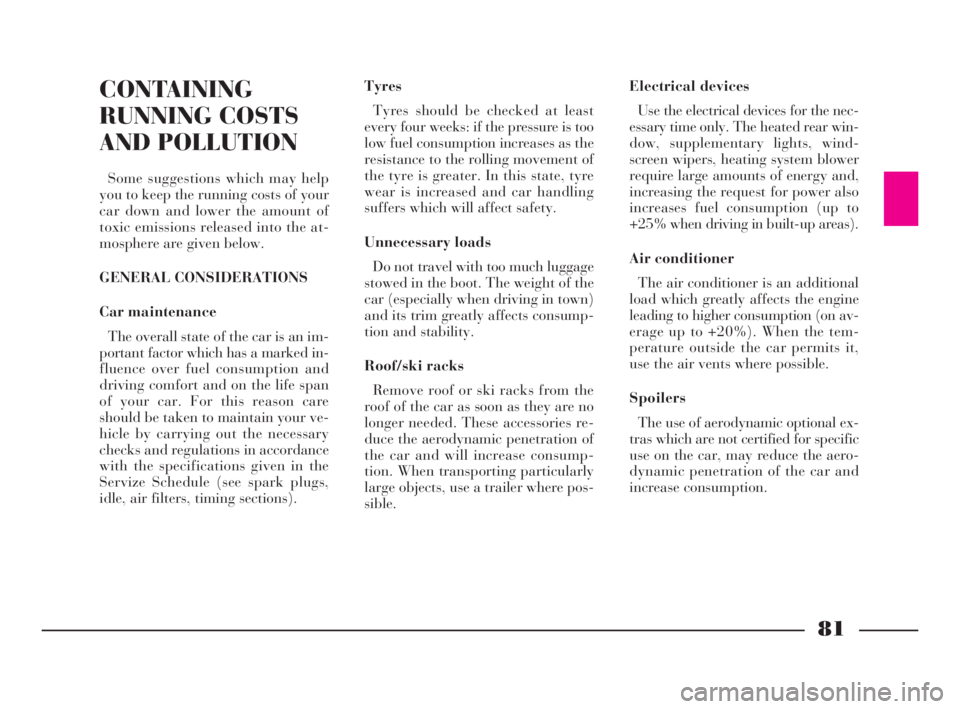
81
G
CONTAINING
RUNNING COSTS
AND POLLUTION
Some suggestions which may help
you to keep the running costs of your
car down and lower the amount of
toxic emissions released into the at-
mosphere are given below.
GENERAL CONSIDERATIONS
Car maintenance
The overall state of the car is an im-
portant factor which has a marked in-
fluence over fuel consumption and
driving comfort and on the life span
of your car. For this reason care
should be taken to maintain your ve-
hicle by carrying out the necessary
checks and regulations in accordance
with the specifications given in the
Servize Schedule (see spark plugs,
idle, air filters, timing sections).Tyres
Tyres should be checked at least
every four weeks: if the pressure is too
low fuel consumption increases as the
resistance to the rolling movement of
the tyre is greater. In this state, tyre
wear is increased and car handling
suffers which will affect safety.
Unnecessary loads
Do not travel with too much luggage
stowed in the boot. The weight of the
car (especially when driving in town)
and its trim greatly affects consump-
tion and stability.
Roof/ski racks
Remove roof or ski racks from the
roof of the car as soon as they are no
longer needed. These accessories re-
duce the aerodynamic penetration of
the car and will increase consump-
tion. When transporting particularly
large objects, use a trailer where pos-
sible.Electrical devices
Use the electrical devices for the nec-
essary time only. The heated rear win-
dow, supplementary lights, wind-
screen wipers, heating system blower
require large amounts of energy and,
increasing the request for power also
increases fuel consumption (up to
+25% when driving in built-up areas).
Air conditioner
The air conditioner is an additional
load which greatly affects the engine
leading to higher consumption (on av-
erage up to +20%). When the tem-
perature outside the car permits it,
use the air vents where possible.
Spoilers
The use of aerodynamic optional ex-
tras which are not certified for specific
use on the car, may reduce the aero-
dynamic penetration of the car and
increase consumption.
4C068-089 ING 11-03-2008 11:59 Pagina 81
Page 125 of 191
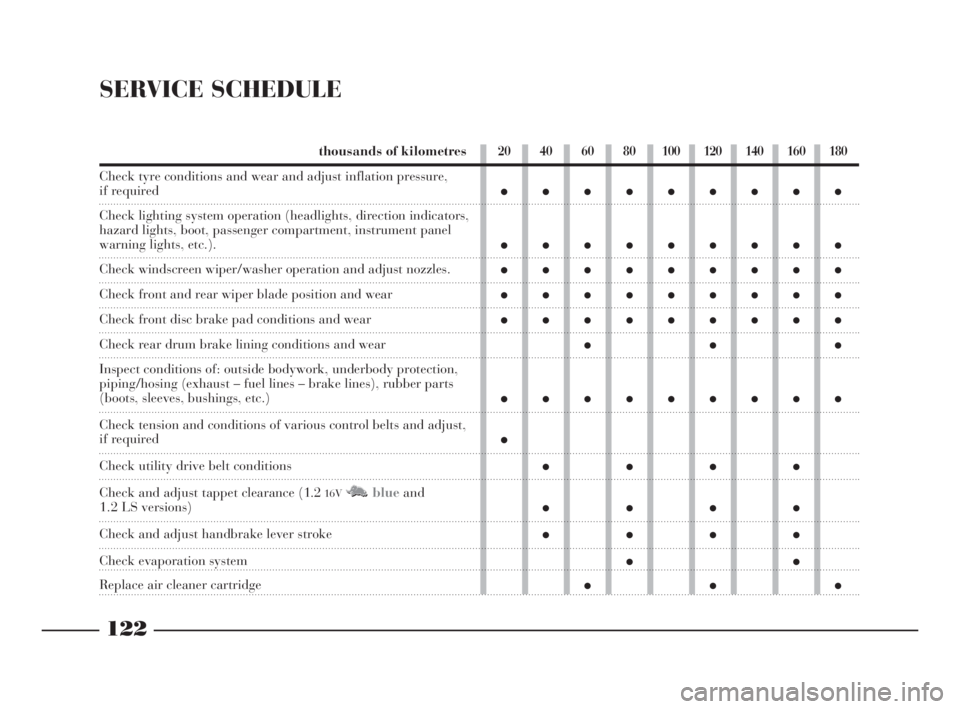
122
G
SERVICE SCHEDULE
thousands of kilometres
Check tyre conditions and wear and adjust inflation pressure,
if required
Check lighting system operation (headlights, direction indicators,
hazard lights, boot, passenger compartment, instrument panel
warning lights, etc.).
Check windscreen wiper/washer operation and adjust nozzles.
Check front and rear wiper blade position and wear
Check front disc brake pad conditions and wear
Check rear drum brake lining conditions and wear
Inspect conditions of: outside bodywork, underbody protection,
piping/hosing (exhaust – fuel lines – brake lines), rubber parts
(boots, sleeves, bushings, etc.)
Check tension and conditions of various control belts and adjust,
if required
Check utility drive belt conditions
Check and adjust tappet clearance (1.2
16VM Nblueand1.2 LS versions)
Check and adjust handbrake lever stroke
Check evaporation system
Replace air cleaner cartridge
20 40 60 80 100 120 140 160 180
●●●●●●●●●
●●●●●●●●●
●●●●●●●●●
●●●●●●●●●
●●●●●●●●●
●●●
●●●●●●●●●
●
●●●●
●●●●
●●●●
●●
●●●
4C120-143 ING 11-03-2008 12:01 Pagina 122
Page 127 of 191
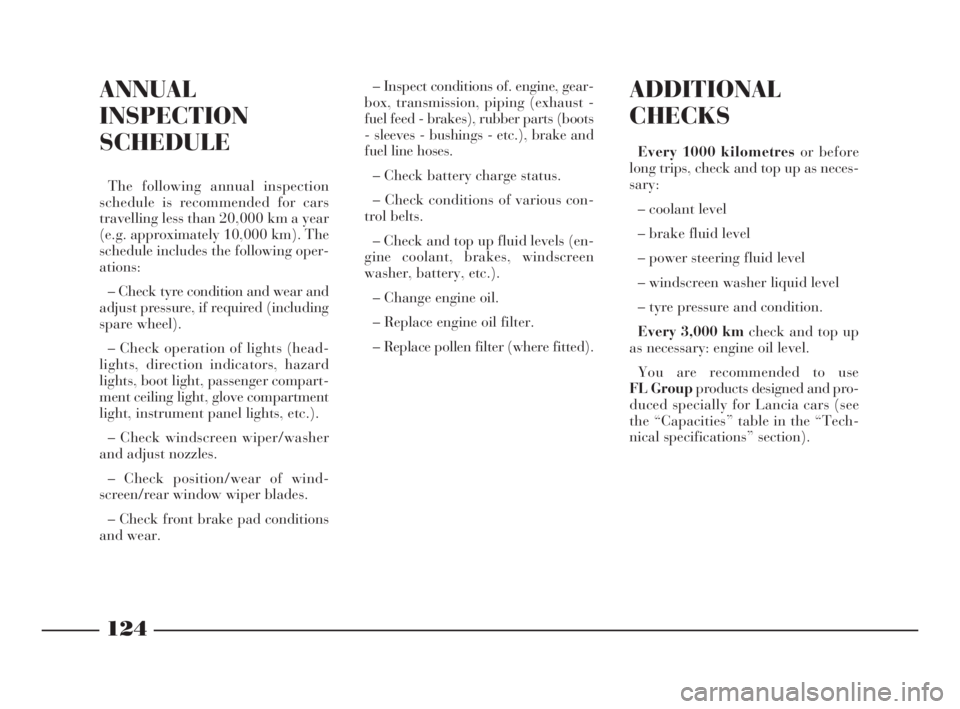
124
G
ADDITIONAL
CHECKS
Every 1000 kilometres or before
long trips, check and top up as neces-
sary:
– coolant level
– brake fluid level
– power steering fluid level
– windscreen washer liquid level
– tyre pressure and condition.
Every 3,000 kmcheck and top up
as necessary: engine oil level.
You are recommended to use
FL Groupproducts designed and pro-
duced specially for Lancia cars (see
the “Capacities” table in the “Tech-
nical specifications” section).
ANNUAL
INSPECTION
SCHEDULE
The following annual inspection
schedule is recommended for cars
travelling less than 20,000 km a year
(e.g. approximately 10,000 km). The
schedule includes the following oper-
ations:
– Check tyre condition and wear and
adjust pressure, if required (including
spare wheel).
– Check operation of lights (head-
lights, direction indicators, hazard
lights, boot light, passenger compart-
ment ceiling light, glove compartment
light, instrument panel lights, etc.).
– Check windscreen wiper/washer
and adjust nozzles.
– Check position/wear of wind-
screen/rear window wiper blades.
– Check front brake pad conditions
and wear.– Inspect conditions of. engine, gear-
box, transmission, piping (exhaust -
fuel feed - brakes), rubber parts (boots
- sleeves - bushings - etc.), brake and
fuel line hoses.
– Check battery charge status.
– Check conditions of various con-
trol belts.
– Check and top up fluid levels (en-
gine coolant, brakes, windscreen
washer, battery, etc.).
– Change engine oil.
– Replace engine oil filter.
– Replace pollen filter (where fitted).
4C120-143 ING 11-03-2008 12:01 Pagina 124
Page 147 of 191
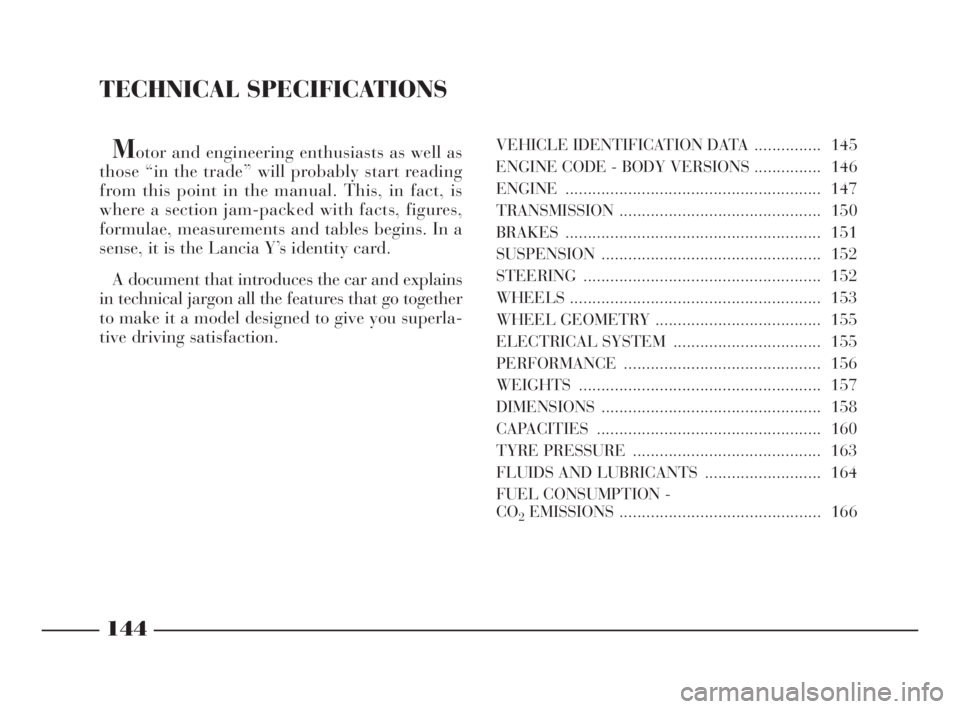
TECHNICAL SPECIFICATIONS
Motor and engineering enthusiasts as well as
those “in the trade” will probably start reading
from this point in the manual. This, in fact, is
where a section jam-packed with facts, figures,
formulae, measurements and tables begins. In a
sense, it is the Lancia Y’s identity card.
A document that introduces the car and explains
in technical jargon all the features that go together
to make it a model designed to give you superla-
tive driving satisfaction.VEHICLE IDENTIFICATION DATA ............... 145
ENGINE CODE - BODY VERSIONS............... 146
ENGINE......................................................... 147
TRANSMISSION............................................. 150
BRAKES......................................................... 151
SUSPENSION ................................................. 152
STEERING..................................................... 152
WHEELS........................................................ 153
WHEEL GEOMETRY ..................................... 155
ELECTRICAL SYSTEM ................................. 155
PERFORMANCE............................................ 156
WEIGHTS...................................................... 157
DIMENSIONS................................................. 158
CAPACITIES .................................................. 160
TYRE PRESSURE .......................................... 163
FLUIDS AND LUBRICANTS .......................... 164
FUEL CONSUMPTION -
CO
2EMISSIONS ............................................. 166
144
G
4C144-167 ING 11-03-2008 12:02 Pagina 144
Page 151 of 191

148
G
FUEL SUPPLY / IGNITION
1.2 versions
Integrated electronic injection and
ignition system: a single electronic
control unit controls both functions.
It processes both the time the injec-
tion lasts (for fuel metering) and the
spark advance angle.
– Type: ......................Multi-point.
– Method of measuring the amount
of aspirated air for petrol metering:
“Speed density” (*).
– “Closed loop”: information on
combustion for correct petrol meter-
ing achieved by means of two lambda
sensors (one upstream and the other
downstream with respect to the catal-
yser).– Electric petrol pump: in-tank.
– Injection pressure: ......... 3.5 bar.
– Air cleaner: dry-type with paper
filter element.
– Firing order: ................1-3-4-2.
– Engine idling speed: 750±50 rpm.
– Spark plugs:
Champion.................RC10YCC
NGK ........................... BKR5EZ1.216Vversions
Integrated electronic injection and
ignition system: a single electronic
control unit controls both functions.
It processes both the time the injec-
tion lasts (for fuel metering) and the
spark advance angle.
– Type: ......................Multi-point.
– Method of measuring the amount
of aspirated air for “Speed density”
petrol metering (*).
– “Closed loop”: information on
combustion for correct petrol meter-
ing achieved by means of two lambda
sensors (one upstream and the other
downstream with respect to the catal-
yser).
– Electric petrol pump: in-tank.
4C144-167 ING 11-03-2008 12:02 Pagina 148
Page 152 of 191

149
G
– Injection pressure: ......... 3.5 bar.
– Air cleaner: dry-type with paper
filter element.
– Firing order: ................1-3-4-2.
– Engine idling speed: 700±50 rpm.
– Spark plugs:
NGK ..........................DCPR8E-N
(*) Analytic method, by electronically process-
ing data from the engine rpm (speed) sensor
and from the air temperature and absolute pres-
sure sensors in the intake manifold (density).
LUBRICATION
Forced-fed with gear pump with
pressure relief valve incorporated.
Oil purification through full-flow
cartridge filter.
COOLING
Cooling system with radiator, cen-
trifugal pump and expansion tank.
“Fixed by-pass” thermostat(1.2 en-
gine)” on the secondary circuit for the
recirculation of water from the engine
to the radiator.
Electric fan for radiator cooling on
the radiator with switching on/off
controlled by thermostatic switch lo-
cated on the radiator. Modifications or repairs
to the fuel feed system that
are not carried out prop-
erly or do not take the system’s
technical specifications into ac-
count can cause malfunctions with
the risk of fire.
4C144-167 ING 11-03-2008 12:02 Pagina 149
Page 189 of 191
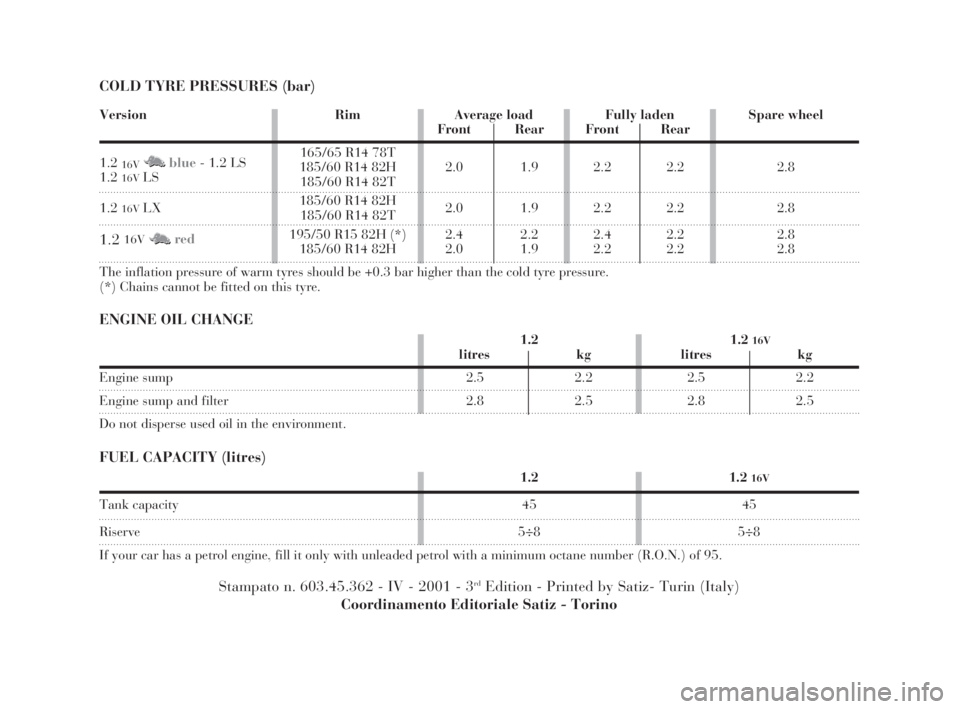
fdG
Stampato n. 603.45.362 - IV - 2001 - 3rdEdition - Printed by Satiz- Turin (Italy)
Coordinamento Editoriale Satiz - Torino
COLD TYRE PRESSURES (bar)
ENGINE OIL CHANGE
FUEL CAPACITY (litres)
Version Rim Average load Fully laden Spare wheelFront Rear Front Rear
165/65 R14 78T
1.2
16VM Nblue- 1.2 LS
185/60 R14 82H 2.0 1.9 2.2 2.2 2.81.216VLS
185/60 R14 82T
1.2
16VLX185/60 R14 82H
2.0 1.9 2.2 2.2 2.8185/60 R14 82T
1.216VM Nred195/50 R15 82H (*) 2.4 2.2 2.4 2.2 2.8185/60 R14 82H 2.0 1.9 2.2 2.2 2.8
The inflation pressure of warm tyres should be +0.3 bar higher than the cold tyre pressure.
(*) Chains cannot be fitted on this tyre.
1.2 1.2
16Vlitres kg litres kg
Engine sump 2.5 2.2 2.5 2.2
Engine sump and filter 2.8 2.5 2.8 2.5
Do not disperse used oil in the environment.
1.2 1.2 16V
Tank capacity 45 45
Riserve 5÷8 5÷8
If your car has a petrol engine, fill it only with unleaded petrol with a minimum octane number (R.O.N.) of 95.
4C177-184 Indice ING 13-03-2008 13:31 Pagina cop3